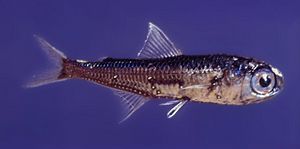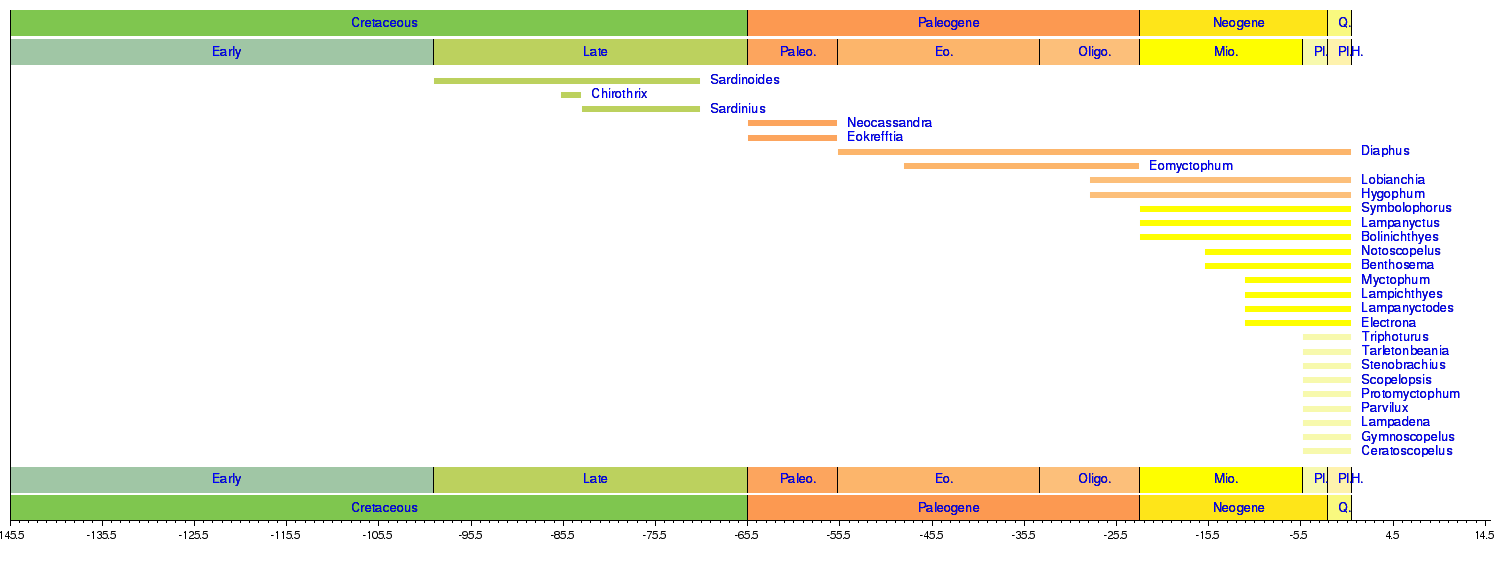Myctophiformes facts for kids
Quick facts for kids Myctophiformes |
|
|---|---|
 |
|
| Spotted lanternfish (Myctophum punctatum) | |
| Scientific classification |
|
| Kingdom: | Animalia |
| Phylum: | Chordata |
| Class: | Actinopterygii |
| Clade: | Neoteleostei |
| Superorder: | Scopelomorpha |
| Order: | Myctophiformes Regan, 1911 |
| Families | |
|
Myctophidae |
|
The Myctophiformes are an order of ray-finned fish. This group includes two main families of fish that live in the deep sea. The most well-known are the lanternfishes, which are very common. The other family, called blackchins, has six species in three groups. Lanternfishes are much more diverse, with over 30 groups and about 252 different species!
The scientific name, Myctophiformes, comes from Ancient Greek words. Myktér means "nose," and óphis means "serpent." The Latin word forma means "external form." These names describe the fish's long, thin body and large head.
Discovering Deep-Sea Fish
These fish are usually small. They live in the pelagic (open water) and benthopelagic (near the seafloor) parts of the deep sea. They are flattened from side to side, like a pancake. Most of them have special light-producing organs called photophores. These lights help them see in the dark ocean.
Their eyes are very big, and some even have huge eyes that point straight out to the sides. Their mouths are also quite large and are at the very tip of their snout. Their mouths can open wide, even past their eyes. Myctophiformes also have a small, fleshy fin called an adipose fin on their back, near their tail. Most of these fish have eight rays in their pelvic fins (the fins on their belly). They also usually have between six and twelve branchiostegal rays, which are bony supports under their gills.
Families of Myctophiformes
The Myctophiformes order includes two main families:
- Myctophidae – These are the lanternfishes, known for their light organs.
- Neoscopelidae – These are the blackchins.
Scientists study how these fish are related to other fish groups. Myctophiformes are similar in body structure to grinner fish (Aulopiformes). They are also thought to be related to more advanced fish called Teleostei, which have spiny fins. Scientists use different methods, including studying their body parts and their DNA, to figure out these relationships. The way fish are grouped and named is called taxonomy, and scientists are always learning more about how all fish are connected.
Timeline of Genera

See also

- In Spanish: Mictofiformes para niños

